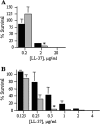Haemophilus ducreyi is resistant to human antimicrobial peptides
- PMID: 17620373
- PMCID: PMC2043175
- DOI: 10.1128/AAC.00473-07
Haemophilus ducreyi is resistant to human antimicrobial peptides
Abstract
We examined the susceptibility of Haemophilus ducreyi to antimicrobial peptides likely to be encountered in vivo during human infection. H. ducreyi was significantly more resistant than Escherichia coli to the bactericidal effects of all peptides tested. Class I and II H. ducreyi strains exhibited similar levels of resistance to antimicrobial peptides.
Figures




Similar articles
-
Haemophilus ducreyi SapA contributes to cathelicidin resistance and virulence in humans.Infect Immun. 2010 Mar;78(3):1176-84. doi: 10.1128/IAI.01014-09. Epub 2010 Jan 19. Infect Immun. 2010. PMID: 20086092 Free PMC article.
-
In vitro susceptibility of Haemophilus ducreyi to several antibiotics.Microbios. 1993;74(299):103-9. Microbios. 1993. PMID: 8361391
-
Antimicrobial susceptibility of 103 strains of Haemophilus ducreyi isolated in Johannesburg.Antimicrob Agents Chemother. 1982 Oct;22(4):686-8. doi: 10.1128/AAC.22.4.686. Antimicrob Agents Chemother. 1982. PMID: 6983858 Free PMC article.
-
Chancroid and Haemophilus ducreyi: an update.Clin Microbiol Rev. 1995 Jul;8(3):357-75. doi: 10.1128/CMR.8.3.357. Clin Microbiol Rev. 1995. PMID: 7553570 Free PMC article. Review.
-
Antimicrobial susceptibility of Haemophilus ducreyi.Antimicrob Agents Chemother. 1990 Jul;34(7):1303-7. doi: 10.1128/AAC.34.7.1303. Antimicrob Agents Chemother. 1990. PMID: 2201248 Free PMC article. Review. No abstract available.
Cited by
-
Bacterial resistance to antibacterial agents: Mechanisms, control strategies, and implications for global health.Sci Total Environ. 2023 Feb 20;860:160461. doi: 10.1016/j.scitotenv.2022.160461. Epub 2022 Nov 23. Sci Total Environ. 2023. PMID: 36435256 Free PMC article. Review.
-
The Human Skin Microbiome Associates with the Outcome of and Is Influenced by Bacterial Infection.mBio. 2015 Sep 15;6(5):e01315-15. doi: 10.1128/mBio.01315-15. mBio. 2015. PMID: 26374122 Free PMC article.
-
Haemophilus ducreyi SapA contributes to cathelicidin resistance and virulence in humans.Infect Immun. 2010 Mar;78(3):1176-84. doi: 10.1128/IAI.01014-09. Epub 2010 Jan 19. Infect Immun. 2010. PMID: 20086092 Free PMC article.
-
The role of bacterial transport systems in the removal of host antimicrobial peptides in Gram-negative bacteria.FEMS Microbiol Rev. 2022 Nov 2;46(6):fuac032. doi: 10.1093/femsre/fuac032. FEMS Microbiol Rev. 2022. PMID: 35749576 Free PMC article. Review.
-
On the physiology and pathophysiology of antimicrobial peptides.Mol Med. 2009 Jan-Feb;15(1-2):51-9. doi: 10.2119/molmed.2008.00087. Epub 2008 Nov 10. Mol Med. 2009. PMID: 19015736 Free PMC article. Review.
References
-
- Agerberth, B., J. Charo, J. Werr, B. Olsson, F. Idali, L. Lindbom, R. Kiessling, H. Jörnvall, H. Wigzell, and G. H. Gudmundsson. 2000. The human antimicrobial and chemotactic peptides LL-37 and α-defensins are expressed by specific lymphocyte and monocyte populations. Blood 96:3086-3093. - PubMed
-
- Al-Tawfiq, J. A., A. C. Thornton, B. P. Katz, K. R. Fortney, K. D. Todd, A. F. Hood, and S. M. Spinola. 1998. Standardization of the experimental model of Haemophilus ducreyi infection in human subjects. J. Infect. Dis. 178:1684-1687. - PubMed
-
- Bauer, M. E., C. A. Townsend, A. R. Ronald, and S. M. Spinola. 2006. Localization of Haemophilus ducreyi in naturally acquired chancroidal ulcers. Microb. Infect. 8:2465-2468. - PubMed
Publication types
MeSH terms
Substances
Grants and funding
LinkOut - more resources
Full Text Sources
Medical

